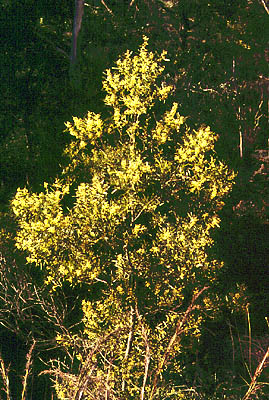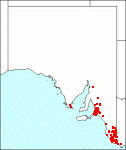Family: Fabaceae
Acacia melanoxylon

Citation:
R. Brown in Ait.f., Hort. Kew, ed.2, 5:462 (1813).
Derivation: melas (Gr.), black; xylon (Gr.), wood. Synonymy: Racosperma melanoxylon (R.Br.)Martius, Hort. Reg. Monac. Semin. (1835). Common name: Blackwood
Description:
Large, symmetrical trees 8-15 m high to 30 m in moist gullies in eastern States and Tas., often with a distinct strong trunk before branching and forming a quite dense dull green canopy; branchlets minutely pubescent and angular but becoming glabrous and marked with light coloured ribs with age; bark dark grey-brown, hard and furrowed. Phyllodes elliptical, lanceolate or oblanceolate, 6-14 cm long, 12-30 mm broad, straight or curved, sometimes falcate, more or less coriaceous, 3-5 prominent longitudinal veins with many finer reticulate veins between them, apex acute or obtuse, tapering towards the base; glands small on upper margin near base. Inflorescences in axillary racemes much shorter than phyllodes, raceme axis hoary with 2-8 heads; flower-heads globular, pale yellow, 30-50-flowered; peduncles stout, hoary, 5-10 mm long; flowers 5-merous. Legumes narrowly oblong, 4-12 cm long, 6-10 mm broad, flattish, curved, coiled and twisted, margins thickened, slightly constricted between seeds. Seeds longitudinal in legume; funicle thick, undulate, pinkish-red, encircling the seed in a double fold.
|
|
Distribution:
|
Blackwood has a limited distribution in S.Aust. being found only in the high rainfall areas of the Northern and Southern Lofty, and South-Eastern regions: there is a small local occurrence near Wirrabara in the Flinders Ranges region (southern part). This species is found in woodland or open forest associated with Eucalyptus obliqua and E. baxteri and prefers cool moist situations of valleys and flats. Soils: sandy, alkaline, yellow duplex, hard acidic yellow duplex and grey-brown calcareous earths. Rainfall 500-1 000 mm. Also Qld, N.S.W., A.C.T., Vic. and Tas.
S.Aust.: EP, NL, MU, SL, KI, SE.
|
Conservation status:
This species is considered by Lang & Kraehenbuehl (1987) to be Inadequately known in its outlying stands. Flowering time: August — October. |

SA Distribution Map based
on current data relating to
specimens held in the
State Herbarium of South Australia
|
Biology:
No text
Related taxa:
Often confused with Acacia implexa Benth. which can be distinguished by its glaucous branches, its phyllodes more attenuated at base and its funicle not encircling the seeds. A. implexa occurs in Qld, N.S.W., A.C.T., Vic., not S.Aust.
Taxonomic notes:
Seed and phyllode variation in blackwood was studied intensively by Farrell & Ashton (1978). Phyllodes tend to be smaller and more symmetric in the drier-inland areas. The largest phyllodes were found in south-west Victoria (probably extending into the far southeast of South Australia). Some differences in seed size were found but were not clearly related to environmental conditions. The role of fire was important in the ecology of the species which regenerates freely from soil-stored seed after fire or when the soil is exposed or disturbed. Some evidence was found that soil-stored seed is viable for at least 50 years. The pods from northern populations (i.e. Qld) tend to be smaller and more convoluted. The late development of the phyllode of blackwood after the juvenile pinnate leaf phase is well known. Seedling populations from 17 sites but not including a South Australian sample were tested under uniform conditions. The onset of phyllode development after the juvenile phase ranged from 2 months to 7 months. Significant differences between populations were correlated with the wide range of climatic variables. Phyllodes were produced more rapidly on populations from drier sites, and the relative size of the bipinnate leaf was related to the site rainfall. The cell structure and morphology of the phyllode of A. melanoxylon was studied by Boke (1940). The finer details are not relevant here. He concluded that Acacia phyllodes are homologous with the petiole-rachis of a pinnate leaf. A. melanoxylon has been popular as an ornamental timber. The heartwood is attractively coloured, strong, close-grained, dresses well and is widely used for furniture and cabinet work. However trunks are often limited in size and supply as almost all the larger trees have now been removed. It also makes a good fuel. Three mistletoes have been recorded on A. melanoxylon. There is a single record of Lysiana exocarpi and many more, but almost equal, numbers of Amyema preissii, wire-leaved mistletoe and Amyema pendulum, drooping mistletoe, more often found on Eucalyptus. A. melanoxylon has been very successful in South Africa, Ross (1975) where it is now established in several provinces. Like A. cyclops and A. saligna it is also invading and displacing indigenous vegetation. It is locally established in southern Europe and occasionally established in California. A. melanoxylon is now naturalised in New Zealand, Webb et al. (1988). A. melanoxylon is included in Boland et al. (1984) 'Forest Trees of Australia' where a description, illustration and a map are given. Two trees of A. melanoxylon in cultivation in the Waite Arboretum lived for 30 and 32 years.
Cultivation:
An attractive tree with a dense crown and shapely habit suitable as an ornamental and as a shade tree in cool mountainous climates where the soil is rich, loamy and acid. Blackwood has also been planted in a number of overseas countries. A moderate growth rate.
Author:
Not yet available
Source:

|

